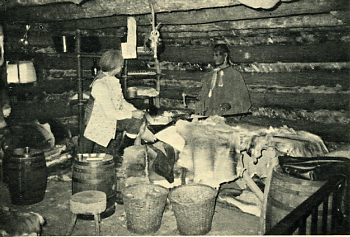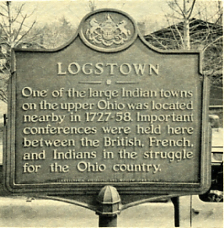
Typical Trading Post.
Click Here to Return to Milestones

George Croghan reached Logstown in August, 1749, shortly after Celeron had departed on his lead marker journey, and found the tribes particularly angry about the lead plates, which they regarded as; an attempt to appropriate their land. As proof of his own popularity he learned that on August 2nd the three principal Iroquois chiefs in the Ohio area, Johonerissa, Scaroyadia, and Cosswentanicea, had granted him 200,000 acres in the vicinity of the forks of the Ohio river in return for an immense assortment of Indian goods.
He advised the Board of Trade in London this was in recognition of his "constant attention to the preservation of peace and as a testimony of the sincerity with which they desired its continuance . . ." He accepted it, he said, "with a view of preserving the British interest among the Indians" and "at a very large expense made them several large presents out of his own private fortune in token of his gratitude and sense he had for their regard."
Whatever the circumstances, there was no doubt of the grant which the Onondaga Council later reconfirmed in 1768 at the Treaty of Fort Stanwix. It gave Croghan the distinction of being the only Pennsylvanian, apart from the Penns, to receive so much land for his own use.
The land he acquired was in three parcels, one of 40,000 acres just east of Fort Pitt, one of 60,000 acres located on both sides of the Youghiogheny at the mouth of Sewickley Creek, and one of 100,000 acres west of the lower Monongahela and along the west side of the Ohio River as far as Raccoon Creek in what is now Beaver County.
The deed was recorded in Philadelphia in 1769, and in Augusta County, VA in 1775, again in Pittsburgh in 1775 and at Staunton, VA in 1777. George Croghan wasn't taking any chances with his rightful claim to the land which probably explains why he recorded it so many times and in so many places. Besides, the territory in what is now Western Pennsylvania was strongly contested by Virginia as belonging to them and the Ohio Company's land grant by the crown was .,proof" of that claim.
With colonial ownership of the area in dispute, Croghan was trying to safeguard his claim by recording the deed in both Pennsylvania and Virginia, in case the land would fall into one or the other of the colonies he was assured a legal right of having it recorded in both jurisdictions.

In researching the Croghan land deal in the Western Pennsylvania Historical Society Archives it was possible to obtain a copy of the deed which included a list of the goods he traded for the land. It was a staggering amount of merchandise as the listing here reveals. I attempted to calculate how much it all might have weighed, and came to an estimated total of 5,000 pounds, or two and a half tons! The question then becomes how did he manage to get 5,000# of goods from Philadelphia to Fort Pitt in 1749, with mountains and streams and hostile Indians all along the way to impede his progress.
Of course, the only way was with pack horses, it was the way all the traders carried their wares through the wilderness. A strong and healthy pack horse can carry about 200#, which is the average weight of a man, so the merchandise had to be bundled in 200# parcels, then secured on the animals back using a wooden frame that spread the load as evenly as possible on each side of the horse so it could carry a balanced load.
Croghan would have needed a string of at least 25 pack horses to carry 5,000# of goods over the mountains. An additional 25 horses was also needed to spell-off the other string every other day. Two strings of 25 horses means at least four wranglers to keep the pack trains moving and safe from Indian interference. Fording or swimming across every stream, loading and unloading each day to alternate the tired horses for fresh ones, and securing the packs, medicating saddle sores on both horses and men, mending broken harness and tack, trying to stay dry in a pouring rain, struggling over rock-ribbed and steep mountain trails made the effort super human in scope. But the driving force of trading goods with the Indians for furs that could be sold in Philadelphia at a handsome profit or traded for thousands of acres of pristine, virgin land with a beautiful vista of 40 miles up an unblemished valley made it all worthwhile.
It's been estimated there were some 300 Indian traders in Pennsylvania in the mid 1700's and one third of them were in some way or another connected with George Croghan, which is an indication of his influence and strength in the trade. He controlled the activities of many independent traders, agents, indentured servants, employees, Negro slaves and knew the Indian language and dialects of over a dozen nations. His prominence earned him the title, "king of the traders." The Indians loved him for his fairness and honesty and not cheating them in the exchange of trade goods and furs. He had such power over Indian behavior, and wss able to save white settlers, from Indian tomahawks more than once. It's a pity history books do not grant him the stature in American history that he deserves.

INDIAN GOODS TRADED BY
CROGHAN FOR 200,000
ACRES OF LAND ON
AUGUST 2,1749
476 Strouds (this was a heavy,
roughly-woven Wool blanket)
800 Duffield Blankets, (a lighter,
finer woven blanket)
910 Pair of 1/2 thick stockings,
(usually thigh length)
400 Shirts, (usually of cotton
material)
40 Pcs. of Calico, (unprinted and
uncolored)
32 Pcs. Callimanco, (colored
cloth)
40 Pcs. embossed serge, (a twil-
led, worsted woolen fabric)
100# Vermillion (red paint)
100 Gross of gartering, (small
bundles of narrow cloth
strips)
100 Pcs. of ribbon, (a brightly
colored strip of cotton cloth)
100 Dozen Scalping knives
1000# Gun powder, (black powder)
2000# Lead bars, (for making bul-
lets)
5000 Gun flints, (for flint-lock
rifles)
100# Brass kettles
10# Thread, (cotton)
2000 Needles
20 Dozen Jews Harps (this item
surprised me)
30 Dozen of tobacco tongs,
(Twists of tobacco)
200# Leaf tobacco (packed in small
bales)
This was the total amount of merchandise traded for all 200,000 acres. Each parcel of land received a portion of this list in accordance with the size of the parcel, i.e. the larger the acreage, the larger the amount of goods that was given. The deed spelled out the exact amounts for each piece of ground.
Pennsylvania - The Colonial Years -
1681-1776, Joseph J. Kelly, Doubleday
1980. pages 272-3.
George Croghan, Wilderness Diplomat Wainwright, University of North Carolina Press, 1959. Pages 28-29.
George Croghan and the Western Movement - 1741-1782 by Albert T. Volwiler, Arthur Clark Co. 1926. Page 236 & 255.
The Western Pennsylvania Historical Society. Library and Archives Department, 4338 Bigelow Blvd., Pittsburgh, PA, Dr.
Carolyn Shumacher, Archivist and Head Librarian.
Map of Croghans land purchases by Bob Barensfeld,
1995.